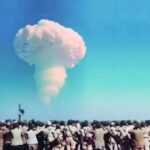Medical isotope production: The US must follow South Africa’s lead
By , William C. Potter | December 17, 2010
A major outcome of the April 2010 Nuclear Security Summit in Washington, DC, was the commitment by 47 nations to collaborate in developing new technologies that require neither highly enriched uranium (HEU) fuels for reactor operation nor HEU targets for producing medical or other isotopes. This principle of HEU minimization also was included in the final document of the 2010 Non-Proliferation Treaty Review Conference, which was adopted by consensus. These initiatives were particularly encouraging because they had the support of a number of countries, such as South Africa and Egypt, which, historically, had been wary of endorsing any measures that might be perceived as limiting their peaceful nuclear-use options.
At the summit, South Africa announced that it, quite ambitiously, had not only adopted a national policy of HEU-free production of medical isotopes — that is, using only low-enriched uranium (LEU) for both fuel and targets — but it also had developed the technology to carry it out. In an effort to encourage and assist in South Africa’s transition, the United States provided the country with a $25 million award to help it produce more of this safer material. Regrettably, this significant advance in the international effort to reduce stockpiles of HEU in the civilian nuclear sector has been undermined by the action — or rather inaction — of the US Congress to follow South Africa’s lead. Internationally, such inaction does not bode well for the country that is the leader in combating nuclear terrorism.
The nature of the problem. Natural uranium includes very little — less than one percent — of the fissile isotope uranium 235. HEU, by contrast, consists of at least 20 percent uranium 235 and is created by an industrial process that separates other isotopes from natural uranium. Typically, medical isotopes are produced in research reactors that run on HEU fuel and that irradiate targets with HEU to produce the radioactive isotope molybdenum 99; dedicated processing companies then separate the molybdenum 99 from the targets. These processers place the bulk molybdenum 99 in generators to produce technetium 99m. Ultimately, hospital and other medical pharmacies use “cold kits” to mix the technetium 99m with different solutions to test patients for heart disease, the spread of cancer, or other ailments — there are nearly 50 million medical diagnostic imaging procedures each year (14 million in the US alone). Since molybdenum 99 has a half-life of 66 hours and technetium 99m only has a half-life of 6 hours, and thus cannot be stockpiled, medical isotopes must be produced and shipped continuously and used within a few days. In the past this meant that isotope reactor operators always kept a continuous supply of weapons-grade HEU on hand, but new technical advances in South Africa and elsewhere mean molybdenum 99 now can be produced from the more secure LEU.
For more than three decades, the US government has sought to phase out the use of HEU in research reactors, as the same material can be used as the essential fissile material in nuclear weapons. The Energy Department’s Reduced Enrichment for Research and Test Reactors (RERTR) program has converted dozens of reactors around the world from HEU to LEU while shutting down other underutilized HEU facilities. Most of the world’s molybdenum 99 comes from only five research reactors: Canada’s NRU, the Netherlands’ HFR, Belgium’s BR-2, France’s Osiris, and South Africa’s Safari-1. While some of these reactors have shifted to LEU fuels, only South Africa has begun using LEU targets — sending its first commercial batch of LEU-based fuel to the United States in July 2010. In doing so, South Africa became the first of the big five producers to join much smaller and newer producers in Argentina and Australia that use LEU fuels or LEU targets. This welcome nonproliferation and counter-nuclear terrorism achievement, however, may be at risk due to the operation of perceived economic disincentives.
Economic reality. Molybdenum 99 produced from LEU is estimated to be about 20 percent more expensive than that produced from HEU, according to NTP Radioisotopes, a subsidiary of the South African Nuclear Energy Corporation (NECSA). This cost differential is due in part to the fact that employing LEU targets requires a larger mass of uranium.
According to NECSA officials, LEU must be irradiated two to five more times to yield the same amount of molybdenum 99. That means more uranium needs to be processed to extract molybdenum 99 and more waste is produced, all of which are added expenses. And if companies must change their processing systems significantly — as NTP did — this could drive costs even higher.
NTP officials maintain that there is also a smaller additional economic penalty that South Africa pays by using LEU fuel since this both produces more uranium waste and produces a somewhat smaller yield of molybdenum 99 (about 5 percent less) because of a smaller neutron flux. Two other major isotope producers — the Dutch HFR reactor and the Canadian NRU — use LEU fuel, but HEU targets. Thus, they avoid the additional financial penalty, but continue to require stockpiles and shipments of HEU, thereby inviting their associated risks.
At the same time as South Africa is forced to incur higher costs, it is competing against lower-cost HEU producers, and in a market that is anything but free. As a recent OECD report makes clear, the molybdenum 99 market has long been distorted by government subsidies. The most important of these is that the capital costs of molybdenum 99 production are not often factored into the cost that commercial processors have to pay. Typically, governments built and operated reactors for research and then produced molybdenum 99 in small amounts to benefit their citizens. But in recent decades, as demand for medical imaging soared, governments dedicated more reactor time and capacity at certain research reactors to irradiate targets for molybdenum 99 production. Consequently, governments now rely on the private sector to separate molybdenum 99 from the irradiated targets and place this material in technetium generators.
These new molybdenum 99 producers benefit from the fact that, typically, they are charged only for the low marginal operating (costs incurred while producing irradiated targets, not the expensive capital costs of construction or other operations); thus, they are able to acquire irradiated HEU targets at a cost far below their actual costs of production. The OECD report highlights that these subsidies have little effect on the ultimate cost of diagnostic imaging, as irradiation is only a small part of the total cost of these procedures. Nonetheless, they have long discouraged new competitors from entering the molybdenum 99 production market — the major producers all employ reactors that are over 43 years old. Perversely, governments are subsidizing the kind of production they say they want to end.
If anything, this situation appears to be getting worse. Russia’s Research Institute of Atomic Reactors (NIIAR), which uses both HEU fuel and targets, is gearing up to produce an amount of molybdenum 99 equivalent to that of South Africa, representing as much as 30 percent of global demand. In 2007, during a supply crisis in the molybdenum 99 market (caused by breakdowns at some of the older reactors, particularly the Canadian NRU reactor), Poland’s MARIA reactor increased its HEU-based production of molybdenum 99 to fill the gap. Though the crisis has passed, the Polish reactor does not appear to have reduced its production. It too uses HEU fuel and targets. While Poland is on track to convert reactor fuel to LEU in mid-2012 and the reactor would not face technical obstacles to switch to LEU targets, the same cannot be said for Covidien, the firm that separates and purifies the molybdenum 99 from the targets in the Netherlands.
Future response. Nonproliferation advocates, nuclear medicine groups, and LEU-based producers were hopeful that legislation that passed the US House of Representatives by a vote of 400-17 last year would help level the playing field for LEU producers. The measure creates incentives for using LEU-based medical isotopes in the United States, the world’s largest market, including support for domestic isotope production.
The legislation supports domestic isotope production using LEU in three ways. First it authorizes $163 million over five years to foster LEU-based production. Second, it subsidizes the construction of facilities that do not use HEU to produce molybdenum 99, by authorizing government cost-sharing; this would eliminate the disincentives to invest in domestic production facilities. Third, it facilitates operation of new facilities by authorizing the government “to retain responsibility for the final disposition of radioactive waste” under uranium-lease agreements — providing a means to relieve operators of the financial, practical, and legal burden of waste disposal.
If these provisions were enacted, the Energy Department estimates that within seven years LEU-based domestic facilities could produce up to twice or more of the US demand for medical isotopes, thereby making it unnecessary for the United States to import HEU-produced medical isotopes.
The legislation would phase out US exports of HEU to foreign producers of molybdenum 99 within seven to 13 years — this would strongly encourage foreign producers to convert their manufacturing processes to eliminate the use of HEU, which the National Academy of Sciences has concluded is a feasible timeframe. If foreign processors switched to LEU production, the legislation would allow them to retain access to the US market.
The bill was approved by the House, and the Senate Energy and Commerce Committee approved an amended version of the bill. However, one senator, Kit Bond, Republican of Missouri, prevented the Senate from voting on the measure by putting a “hold” on the legislation. Bond argued that the export ban would lead to a decreased production of medical isotopes, but the reverse is true. Another motivation could lie in the fact that the University of Missouri’s research reactor — which opted out of federal funding for the domestic production program — will not benefit from the legislation Bond will retire from the Senate after this session and, fortunately, his elected successor, Roy Blunt, not only voted for the measure in the House but co-sponsored the legislation by Edward Markey, Democrat of Massachusetts, and Fred Upton, Republican of Michigan.
As the self-proclaimed — and actual — leader in combating nuclear terrorism, the Unites States must get its own act together. It cannot preach to other countries about the need to convert research reactors and medical isotope production to LEU when it fails to provide incentives to encourage that development. The United States needs to overcome the obstructionist behavior of one senator and adopt legislation consistent with US nonproliferation and nuclear security policy. Otherwise, it will miss an important opportunity to enhance nuclear security and reduce the risks of nuclear terrorism.
Together, we make the world safer.
The Bulletin elevates expert voices above the noise. But as an independent nonprofit organization, our operations depend on the support of readers like you. Help us continue to deliver quality journalism that holds leaders accountable. Your support of our work at any level is important. In return, we promise our coverage will be understandable, influential, vigilant, solution-oriented, and fair-minded. Together we can make a difference.
Topics: Nuclear Energy, Nuclear Weapons, Opinion















